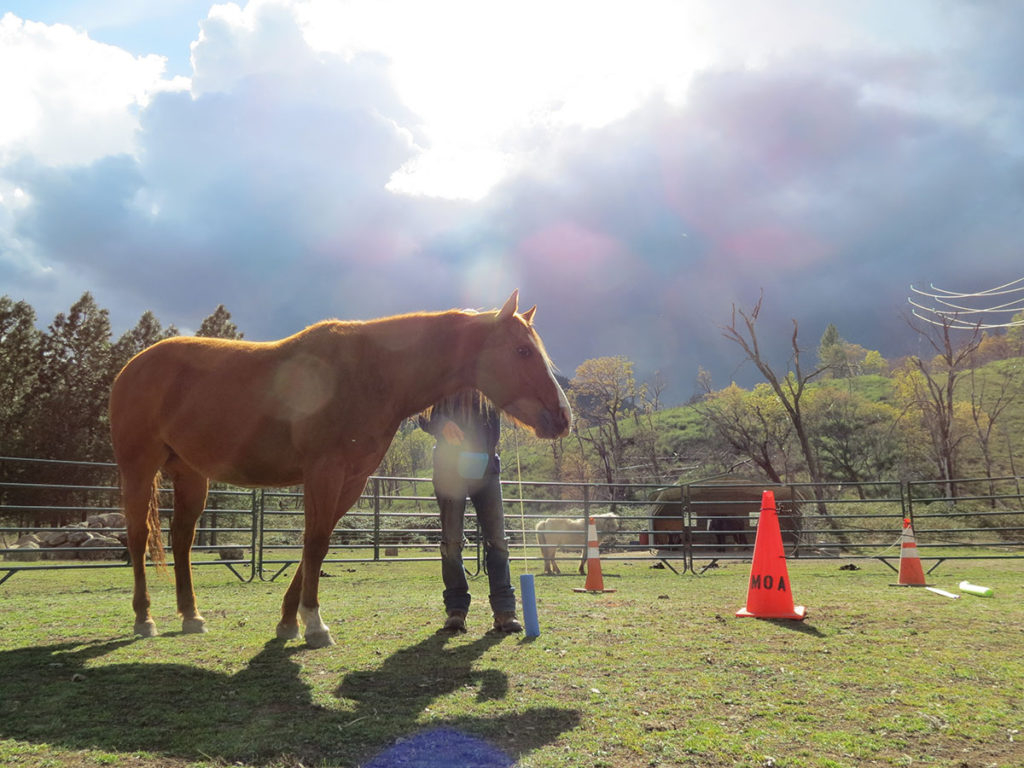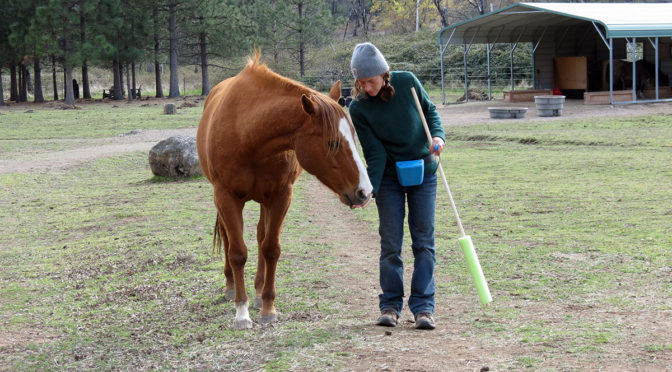“Non-humans are not connected to the world via conceptual mind, and, therefore, they have no problems about Realizing the Non-Dual Nature of Reality Itself. The egoless Nature of Reality Itself is perfectly obvious to the non-humans.”
– Adi Da Samraj
From Observe the Non-Humans, and Learn from Them, a Discourse by Avatar Adi Da Samraj, May 11, 2008
This is an excerpt from our latest FNMZ e-newsletter, please subscribe!
At all Fear-No-More Zoo locations there is an ongoing exploration and consideration of how to rightly orient ourselves to fully serve our non-human residents’ precious native disposition towards contemplation of the Divine. This is foremost in everything we do with our non-human residents. Some of the training we do with our residents is for practical purposes (for example, being able to safely provide veterinary care) but also to provide them with enrichment in the form of playing and having fun.
We are excited to share an innovative form of training that we are doing with the horses at the Mountain Of Attention Sanctuary in California. We are fortunate to have Lotte Braithwaite, Zookeeper of Fear-No-More at the European Danda, onsite in California, to teach us this technique. Lotte has been immersed in several different horse training forms over the years, assessing and considering them all with deep heartfelt intelligence. Lotte is currently immersed in what is generally called Positive Reinforcement Training, which you will see in this video. Here is what she has to say about this technique:
Lotte: Positive reinforcement training, or +R, means that the horse gets rewarded for doing something we ask, this is usually a treat, but it could be scratches or anything that is rewarding to the horse. A tool that is often used with +R is a clicker. The clicker is used to mark the exact moment the horse does a right behaviour and acts as a bridge to the reward. Why is this useful? Well, for the horse to associate a specific behaviour with a reward, he has to receive the reward within a few seconds of doing the behaviour. Any longer than this and it becomes more difficult for the horse to understand what he is being rewarded for, thus slowing down the learning process. The click, to the horse, means the thing he was doing in that moment was good and that the reward is coming. This can also be done with a word/voice cue, but because the clicker makes the exact same sound every time, it’s a clearer signal to the horse, which again, speeds up the learning process. We’ve also found that using the clicker as the marker, gives us more room to use verbal encouragement and praise without the horse expecting a reward for it. They know that the treat only comes after they hear the click.

We set up a training pen in the horse area and started teaching them the basics; loading the clicker and targeting. First of all, the horse needs to learn that the click means the reward is coming. This is easily done by clicking and immediately giving the horse a treat, repeat this a bunch of times and most horses will have made the connection. Click = treat. This is called loading the clicker. Targeting is one of the most versatile and useful things to teach a horse. It’s the basis for a lot of the more complex behaviors that we might want to teach the horse, like walking with you from point A to point B or asking them to give you a certain body part for care/veterinary purposes. To teach targeting you present the horse with something you would like him to touch with his nose. Usually this is a bit of foam/pool noodle on a stick or a cone, but you can use pretty much anything. Horses are curious and will most likely want to touch the new thing you’re showing them. The moment they touch it or move their nose in the right direction, they hear the click and receive a treat. Repeat a number of times and the horse will have learned that touching the target earns him a treat. Now we can ask the horse to follow the target or anything else we might want him to do with it.
With most horses it’s helpful in the very beginning to have some kind of protective barrier between you and the horse. Because there are treats involved, the horse will naturally try to get them directly from your pocket. He hasn’t yet learned that harassing you is never going to get him what he wants. To prevent having to use force or punish the horse while he learns what behaviours do get him the treat, we use a protective barrier, also called being in protective contact. This helps to create space, so the human is safe from being mugged and the horse is more likely to show interest in the target. Positive reinforcement is only one way of training, horses are most commonly trained using pressure and release and this can be used in many different ways. We are in an ongoing consideration about when to use the different ways of teaching the horses and other animals. But positive reinforcement engages the brain’s seeking system, telling the horse to be curious and experiment. Pressure/release shuts the seeking system down, this is why they can’t be used together in a training session or to train a specific behaviour without losing the benefits of using +R. Both ways of training can still be used, as they both have their value depending on the situation, but they have to be clearly separate.
We worked with all the horses except Shady. Shady is elderly and showed no interest in participating beyond sometimes watching from the sidelines, so we left her alone. Dawn and Metu were the most enthusiastic so we worked with them the most. Metu is the star student, he is a fast learner and is very motivated. He is polite and sensitive, but can be quite skittish with various things, including ropes or halters around his head. So with him we focused on exercises that encourage self-confidence and expression. We also started teaching him to willingly put his nose in the halter to help him be more comfortable with it. Dawn has a lot of high energy, confidence and self-expression. She also tends to be quite pushy and in your space, so most of the sessions were focused on targeting puzzles. To create more distance between us and to get Dawn in a calmer and thinking state of mind. She is doing great with this.
You will see in the video that the horses are happily engaged in this training! In a very short time, they started looking forward to the training and would be waiting for Lotte & Sara to arrive so they could start.
Support Fear-No-More Zoo

Connect with us on Facebook, Instagram, and YouTube
Connect with us on social media to stay up to date with what is happening at Fear-No-More Zoo!

